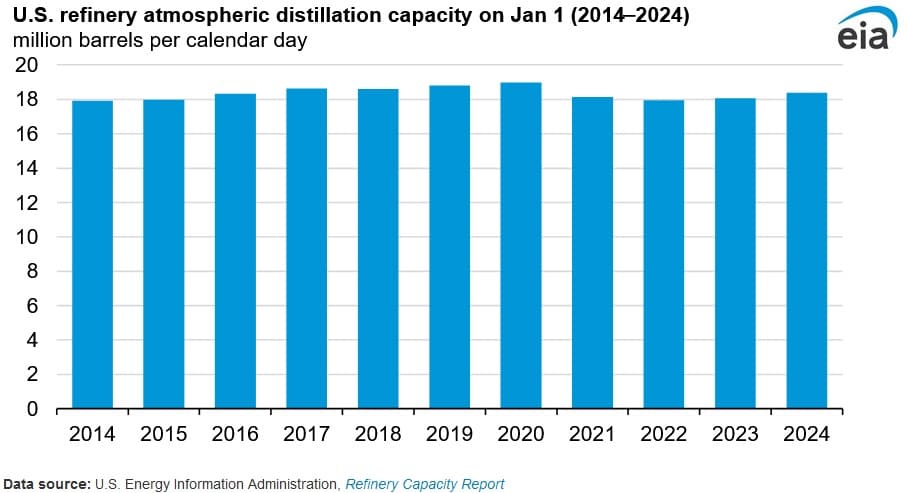Expansions to Existing Facilities Drive U.S. Refinery Capacity Growth: EIA

U.S. refining capacity rose during the start of 2024, according to a July 30 report published by the U.S. Energy Information Administration. U.S. operable atmospheric oil distillation capacity, the key benchmark of refinery capacity, was recorded at 18.4 million barrels per day (b/cd) during the beginning of 2024, up two percent in comparison to the beginning of 2023.
Over the last decade, the majority of the additions to U.S. refinery capacity can be attributed to developments and growth of existing facilities, additions of relatively minor facilities and the reactivation of formerly decommissioned units. Reductions to refinery capacity were on the back of decommissioned facilities due to damage and facilities transitioning from petroleum refining to renewable fuels processing.
ExxonMobil, Valero, and Marathon are the three biggest refiners in the U.S. and they all witnessed an increase in capacity during 2024, compared to 2023. Meanwhile, Phillips 66, the fourth biggest refiner in the U.S., reduced its refining capacity during 2023.
The rise in capacity during the start of 2024 is due to larger capacity at prevailing facilities. Most notably, ExxonMobil finalised a major refinery capacity addition in Texas during March 2023, which increased a facility’s total crude oil distillation capability from 369,000 b/cd to 609,000 b/cd. Moreover, Valero also concluded a development project at its Port Arthur refinery, growing its distillation volume by 25,000 b/cd to 360,000 b/cd. Lastly, Marathon’s Galveston Bay refinery capacity rose by six percent to 631,000 b/cd.
Phillips 66 officially concluded petroleum refinery operations at its Rodeo refinery in February 2024. As of the start of 2024, the company reported a capacity of 58,200 b/cd, having reported a capacity of 120,200 b/cd in 2023. Phillips 66 has been curtailing operations and transitioning to the production of biofuels.
As it stands, there are 132 operating refiners in the U.S., compared to 129 at the beginning of 2023.
EnerKnol Pulses like this one are powered by the EnerKnol Platform—the first comprehensive database for real-time energy policy tracking. Sign up for a free trial below for access to key regulatory data and deep industry insights across the energy spectrum.
ACCESS FREE TRIAL